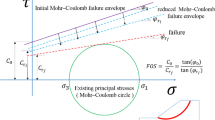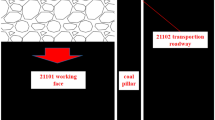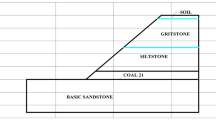Abstract
The stability of high jointed slopes has an important impact on the construction of engineering projects. Herein, aiming at the high jointed slope of mine, by combining the jointed finite element method (JFEM) and the discontinuous deformation analysis (DDA) method, a whole-of-process analysis method was proposed from identification of the slope stability and risk assessment to later optimization of support design. Firstly, the geological generalization model was established according to the results of engineering geological survey. Secondly, JFEM was used to identify the stability and potential sliding surface of slope. Then, the block system model of slope was established based on potential sliding surface, DDA was used to study the instability process of slope, and risk assessment was conducted according to the accumulation range of rock. According to the risk assessment results, whether to undertake industrial production or optimize the support scheme by JFEM was judged. To verify the effectiveness of this method, a typical high jointed slope was taken as a case study. The results showed that the slope was stable under natural condition, the shear failure of leading edge and tensile failure of trailing edge developed upon excavation. According to the accumulation range of rock, the slope was divided into five zones: forbidden operation zone, high-risk zone, medium-risk zone, low-risk zone, and safety zone, and the optimized prestressed anchor cable design scheme was proposed whose prestressed was 2000 kN, length was 60 m, and spacing was 6 m.




















Similar content being viewed by others
References
Azarfar B, Ahmadvavd S, Sattarvand J et al (2019) Stability analysis of rock structure in large slopes and open-pit mine: numerical and experimental fault modeling. Rock Mech Rock Eng 52(12):4889–4905
Bahaaddini M, Sharrock G, Hebblewhite BK (2013) Numerical investigation of the effect of joint geometrical parameters on the mechanical properties of a non-persistent jointed rock mass under uniaxial compression. Comput Geotech 49:206–225
Cambio D, Hicks DD, Moftt K et al (2019) Back analysis of the Bingham Canyon south wall: a quasistatic complex slope movement mechanism. Rock Mech Rock Eng 52(12):4953–4977
Chen KT, Wu JH (2018) Simulating the failure process of the Xinmo landslide using discontinuous deformation analysis. Eng Geol 239:269–281
Dai JH, Yang JH, Yao C et al (2022) Study on the mechanism of displacement mutation for jointed rock slopes during blasting excavation. Int J Rock Mech Min Sci 150:105032
Flores G, Catalan A (2019) A transition from a large open pit into a novel “macroblock variant” block caving geometry at Chuquicamata mine, Codelco Chile. J Rock Mech Geotech Eng 11(3):549–561
Fu XD, Sheng Q, Zhang YH et al (2015a) Application of the discontinuous deformation analysis method to stress wave propagation through a one-dimensional rock mass. Int J Rock Mech Min Sci 80:155–170
Fu XD, Sheng Q, Zhang YH et al (2015b) Boundary setting method for the seismic dynamic response analysis of engineering rock mass structures using the discontinuous deformation analysis method. Int J Numer Anal Methods Geomech 39(15):1693–1712
Fu XD, Sheng Q, Zhang YH et al (2016) Investigation of highly efficient algorithms for solving linear equations in the discontinuous deformation analysis method. Int J Numer Anal Methods Geomech 40(4):469–486
Fu XD, Sheng Q, Zhang YH et al (2017a) Time-frequency analysis of seismic wave propagation across a rock mass using the discontinuous deformation analysis method. Int J Geomech 17(8):04017024
Fu XD, Sheng Q, Zhang YH et al (2017b) Computation of the safety factor for slope stability using discontinuous deformation analysis and the vector sum method. Comput Geotech 92:68–76
Fu XD, Sheng Q, Du WJ et al (2020a) Evaluation of dynamic stability and analysis of reinforcement measures of a landslide under seismic action: a case study on the Yanyangcun landslide. Bull Eng Geol Environ 79(6):2847–2862
Fu XD, Sheng Q, Li G et al (2020b) Analysis of landslide stability under seismic action and subsequent rainfall: a case study on the Ganjiazhai giant landslide along the Zhaotong-Qiaojia road during the 2014 Ludian earthquake, Yunnan. China Bull Eng Geol Environ 79(10):5229–5248
Goodman RE, Taylor RL, Brekke TL (1968) A model for the mechanics of jointed rock. J Soil Mech Found Div 99(5):637–660
Guo N, Yang ZX, Yuan WH et al (2021) A coupled SPFEM/DEM approach for multiscale modeling of large-deformation geomechanical problems. Int J Numer Anal Methods Geomech 45(5):648–667
Hashimoto R, Sueoka T, Koyama T et al (2021) Improvement of discontinuous deformation analysis incorporating implicit updating scheme of friction and joint strength degradation. Rock Mech Rock Eng 54(8):4239–4263
He L, Tian Q, Zhao ZY et al (2018) Rock slope stability and stabilization analysis using the coupled DDA and FEM method: NDDA approach. Int J Geomech 18(6):04018044
He JX, Qi SW, Zhan ZF et al (2021) Seismic response characteristics and deformation evolution of the bedding rock slope using a large-scale shaking table. Landslides 18(8):2835–2853
Kaidi S, Rouainia M, Ouahsine A (2012) Stability of breakwaters under hydrodynamic loading using a coupled DDA/FEM approach. Ocean Eng 55:62–70
Liu HY, Kang YM, Lin P (2013) Hybrid finite–discrete element modeling of geomaterials fracture and fragment muck-piling. Int J Geotech Eng 9(2):115–131
Liu XZ, Tang CA, Li LC et al (2018) Microseismic monitoring and stability analysis of the right bank slope at Dagangshan hydropower station after the initial impoundment. Int J Rock Mech Min Sci 108:128–141
Lu WB, Hu YG, Yang JH et al (2013) Spatial distribution of excavation induced damage zone of high rock slope. Int J Rock Mech Min Sci 64:181–191
Ma K, Liu GY, Guo LJ et al (2020) Deformation and stability of a discontinuity-controlled rock slope at Dagangshan hydropower station using three-dimensional discontinuous deformation analysis. Int J Rock Mech Min Sci 130:104313
Meng QX, Wang HL, Xu WY et al (2019) Multiscale strength reduction method for heterogeneous slope using hierarchical FEM/DEM modeling. Comput Geotech 115:103164
Park MC (2016) Behavior analysis by model slope experiment of artificial rainfall. Nat Hazards Earth Syst Sci 16(3):789–800
Prudencio M, Jan MV (2007) Strength and failure modes of rock mass models with non-persistent joints. Int J Rock Mech Min Sci 44(6):890–902
Rahimi A, Rahardjo H, Leong EC (2011) Effect of antecedent rainfall patterns on rainfall-induced slope failure. J Geotech Geoenviron Eng 137(5):483–491
Sheng Q, Yue ZQ, Lee CF et al (2002) Estimating the excavation disturbed zone in the permanent shiplock slopes of the Three Gorges Project, China. Int J Rock Mech Min Sci 39:165–184
Shi GH (1988) Discontinuous deformation analysis: a new numerical model for the statics and dynamics of block systems. University of California, Berkeley
Song YX, Hunag D, Cen DF (2016) Numerical modelling of the 2008 Wenchuan earthquake-triggered Daguangbao landslide using a velocity and displacement dependent friction law. Eng Geol 215:50–68
Tang SB, Huang RQ, Tang CA et al (2017) The failure processes analysis of rock slope using numerical modelling techniques. Eng Fail Anal 79:999–1016
Tao ZG, Shu Y, Yang XJ et al (2020) Physical model test study on shear strength characteristics of slope sliding surface in Nanfen open-pit mine. Int J Min Sci Technol 30(3):421–429
Vivanco F, Melo F (2013) The effect of rock decompaction on the interaction of movement zones in underground mining. Int J Rock Mech Min Sci 60:381–388
Vyazmensky A, Stead D, Elmo D et al (2009) Numerical analysis of block caving-induced instability in large open pit slopes: A Finite Element/Discrete Element Approach. Rock Mech Rock Eng 43(1):21–39
Wang HB, Zhang B, Mei G et al (2020) A statistics-based discrete element modeling method coupled with the strength reduction method for the stability analysis of jointed rock slopes. Eng Geol 264:105247
Wang MX, Li DQ et al (2021a) Probabilistic seismic displacement hazard assessment of Earth slopes incorporating spatially random soil parameters. J Geotech Geoenviron 147(11):04021119
Wang W, Li DQ, Liu Y et al (2021b) Influence of ground motion duration on the seismic performance of earth slopes based on numerical analysis. Soil Dyn Earthq Eng 143:106595
Williams C, Ross B, Zebker M et al (2021) Assessment of the available historic radarsat-2 synthetic aperture radar data prior to the manefay slide at the Bingham Canyon Mine using modern InSAR techniques. Rock Mech Rock Eng 54(7):3469–3489
Wu FQ, Liu JY, Liu T et al (2009) A method for assessment of excavation damaged zone (EDZ) of a rock mass and its application to a dam foundation case. Eng Geol 104(3–4):254–262
Wu JH, Chen CH (2011) Application of DDA to simulate characteristics of the Tsaoling landslide. Comput Geotech 38(5):741–750
Yang JH, Dai JH, Yao C et al (2020) Estimation of rock mass properties in excavation damage zones of rock slopes based on the Hoek-Brown criterion and acoustic testing. Int J Rock Mech Min Sci 126:104192
Zhang F, Yang TH, Li LC et al (2018) Cooperative monitoring and numerical investigation on the stability of the south slope of the Fushun west open-pit mine. Bull Eng Geol Environ 78(4):2409–2429
Zhang F, Yang TH, Li LC et al (2021a) Assessment of the rock slope stability of Fushun West Open-pit Mine. Arab J of Geosci 14(15):1459
Zhang ZP, Fu XD, Sheng Q et al (2021b) Effect of rainfall pattern and crack on the stability of a red bed slope: a case study in Yunnan province. Adv Civ Eng 2021:1–21
Zhou Q, Xu WJ, Lubbe R (2021) Multi-scale mechanics of sand based on FEM-DEM coupling method. Powder Technol 380:394–407
Zhou YQ, Sheng Q, Li NN et al (2022) The dynamic mechanical properties of a hard rock under true triaxial damage-controlled dynamic cyclic loading with different loading rates: a case study. Rock Mech Rock Eng. https://doi.org/10.1007/s00603-021-02756-w
Zhu C, He MC, Karakus M et al (2020) Investigating toppling failure mechanism of anti-dip layered slope due to excavation by physical modelling. Rock Mech Rock Eng 53(11):5029–5050
Funding
The work reported in this paper is financially supported by the National Natural Science Foundation of China (No. U21A20159; No. 52179117), the Youth Innovation Promotion Association CAS (No.2021325), and the Research project of Panzhihua Iron and Steel Group Mining Co., Ltd. (No. 2021-P6-D2-05).
Author information
Authors and Affiliations
Corresponding author
Rights and permissions
About this article
Cite this article
Kang, J., Wan, D., Sheng, Q. et al. Risk assessment and support design optimization of a high slope in an open pit mine using the jointed finite element method and discontinuous deformation analysis. Bull Eng Geol Environ 81, 254 (2022). https://doi.org/10.1007/s10064-022-02759-z
Received:
Accepted:
Published:
DOI: https://doi.org/10.1007/s10064-022-02759-z




